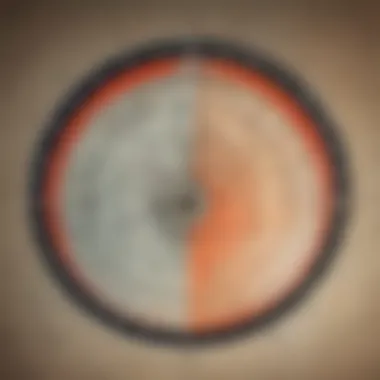Using a Protractor: A Comprehensive Guide to Measurement


Intro
A protractor is a fundamental tool in geometry that enables accurate angle measurement. Understanding how to use this device is crucial, especially for young learners beginning their journey in mathematics. The tool not only assists in measuring angles but also facilitates geometric constructions that are foundational in various scientific and practical applications.
By exploring the various types of protractors, their applications, and common complications that may arise when using them, readers can build a strong baseline knowledge. This article is tailored for elementary school children, parents, and caregivers looking to strengthen their geometrical skills and conceptual understanding of angle measurement.
In this guide, we will cover:
- Definitions and types of protractors.
- Step-by-step instructions on measuring angles.
- Common errors to avoid during usage.
- Real-world applications of protractors.
The goal is to enrich the learning experience through practical exercises, engaging activities, and meaningful discussions, making geometry accessible and fun.
Creative Activities
Engaging with geometrical tools can be exciting through creative activities. Here are some ideas that combine the use of a protractor with craft projects.
Craft Ideas
- Angle Art: Children can create artwork by measuring and drawing different angles with a protractor. Using colored pencils or markers, they can visualize angles creatively.
- Protractor Mobile: Construct a hanging mobile featuring various angles cut out from colored paper. This visual aid will serve as both a decoration and a reference tool.
- Angle Finder: Let children make a simple angle finder using a ruler and paper. They can use it alongside the protractor for double verification of their angle measurements.
Step-by-Step Guides
- Making Angle Art:
- Creating a Protractor Mobile:
- Gather colored paper, scissors, and a protractor.
- Choose angles you want to draw, such as 30°, 45°, or 90°.
- Use the protractor to draw lines forming the angles on the paper.
- Decorate your angles with different colors or patterns.
- Cut out various angles from colored paper.
- Use string to hang the angle pieces at different lengths and angles.
- Display your mobile in a visible area.
Educational Value
These activities enhance fine motor skills and promote a deeper understanding of angles. Young learners can grasp the concept of measurement and see practical applications of their lessons. Crafting also stimulates creativity, making learning an enjoyable experience.
Fun Quizzes
Quizzes provide an interactive way to assess understanding and knowledge retention for children learning about protractors.
Quiz Topics
Quizzes may include topics such as:
- Types of angles (acute, obtuse, right)
- How to properly use a protractor
- Common mistakes when measuring angles
Question Types
To keep children engaged, questions can vary in format:
- Multiple choice questions to identify angles.
- Fill-in-the-blank statements to test definitions.
- Practical measurement scenarios requiring angle calculation.
Knowledge Reinforcement
Quizzes serve as a valuable tool for reinforcing concepts learned in class. Through repetition and varied question types, children solidify their understanding of angles and protractor usage, leading to improved confidence in geometry.
Fact-Based Articles
Supplementing practical exercises with informative articles can expand knowledge on protractors and geometry.
Topics
Some topics to explore may include:


- The history of protractors in mathematics.
- Different types of protractors and their benefits.
- Famous mathematicians and their contributions to geometry.
Engaging Content
Articles presented in a straightforward manner, avoiding jargon, allow young readers to grasp complex concepts easily. Combining images with text can enhance comprehension as well.
Prolusion to Protractors
Protractors are common tools in the field of geometry, used primarily to measure angles. Understanding how to use a protractor effectively is essential for students who are learning basic geometric principles. This section explores the basic definition, historical context, and the significance of protractors in geometry, setting the stage for deeper comprehension and practical usage.
Definition of a Protractor
A protractor is a measuring instrument typically made of transparent plastic or glass, equipped with a semicircular or circular scale. The measurement usually ranges from 0 to 180 degrees in a semicircular form or 0 to 360 degrees in a full circle version. Each degree is marked clearly along the curved edge, making it easy to read angles accurately. Essentially, this tool allows users to identify and measure angles formed by two intersecting lines.
History of Protractors
The origin of protractors dates back to the ancient Greeks, who were the first to chart and measure angles through rudimentary tools. The concept of measuring angles has evolved significantly over centuries. Early forms lacked precision but laid the groundwork for modern protractors. By the Renaissance, advancements in geometry and astronomy led to more sophisticated angle-measuring devices. The popularity of protractors grew, especially with the increased focus on education in mathematics. By the time the 19th century arrived, protractors were standard tools in classrooms worldwide. They became essential not just in education, but also in various professional fields like architecture and engineering.
Importance in Geometry
In geometry, protractors serve several functions. They help students learn about angles and their properties. Angles are vital in many geometric concepts such as triangles, polygons, and circles. With a protractor, one can accurately measure and construct angles, which increases geometric understanding and enhances spatial reasoning. Additionally, writing checks and balancing accounts often involve precise measurements. The skill of using a protractor can empower students to tackle complex mathematical problems later in life. Therefore, mastering this tool is crucial in promoting confidence and competence in geometry.
"Understanding how to use a protractor is a key step in mastering geometry and developing logical reasoning skills."
By exploring the definition, history, and importance of protractors, students and their guardians can appreciate why this tool is fundamental in educational settings.
Types of Protractors
Understanding the various types of protractors is crucial for anyone learning geometry or engaging in any form of angular measurement. Each type caters to specific needs and scenarios, offering distinct features and benefits. Whether you are an elementary school child or a parent assisting with homework, knowing the right type of protractor can enhance the accuracy of measurements and the overall learning experience.
Standard Protractor
The standard protractor is a semicircular tool usually made of plastic or transparent material. It is marked with degrees from 0 to 180 on each side, which helps in measuring angles effectively. This protractor is user-friendly, making it a common choice among students and educators alike.
When using a standard protractor, aligning the baseline of the protractor with one side of the angle is essential. The center hole of the protractor should rest precisely on the vertex of the angle. Once positioned, one can easily read the degree measure where the second line intersects the numbers on the protractor. The straightforward design of the standard protractor allows for a better understanding of angle measurement, making it suitable for beginners.
Adjustable Protractor
The adjustable protractor is more versatile than its standard counterpart. This tool features a movable arm that can pivot around the center point. This design allows for measuring angles greater than 180 degrees and enhances flexibility in usage.
For example, when working with angles in a more complex geometric shape, the adjustable protractor can provide more accurate measurements. To leverage its functionality, one needs to set the arm of the protractor at an angle and lock it in place before reading the measurement. This protractor is recommended for students who are progressing in their geometry skills and need to tackle more challenging problems.
Digital Protractor
Digital protractors represent the innovation in angle measurement tools. They utilize electronic displays to show angle measurements, reducing human error often associated with reading scales. A digital protractor can measure angles instantly, and some models come equipped with additional features like memory functions and the ability to display measurements in different units.
While using a digital protractor, the user simply places the device on the angle, and the digital screen presents the measurement directly. This type is particularly useful for older students who are comfortable with technology and seek precision in their work. However, since digital protractors require batteries, it is essential to ensure they are charged or have functioning batteries before use.
Choosing the right type of protractor can significantly influence the accuracy and enjoyment of learning geometry.
Understanding these types of protractors enables learners to select the appropriate tool for their needs, ensuring effective practice in measuring angles.
Components of a Protractor
Understanding the components of a protractor is essential for effective angle measurement. Each part of this tool plays a crucial role in accuracy and usability. By gaining a solid grasp of these components, users can significantly improve their ability to measure angles precisely and efficiently. This section delves into the three primary parts of a protractor: the edge and scale, the center point, and the measuring arcs. Each of these elements contributes to the overall functionality of the protractor, making it an invaluable tool in both education and practical applications.
Edge and Scale
The edge of a protractor is often straight and typically made of plastic or metal. It serves as the reference line for measuring angles. The scale is marked along the edge, displaying degrees from 0 to 180 on one side and 0 to 180 on the opposite side. This dual scale allows users to measure angles in both directions, enhancing versatility.
When using a protractor, it is vital to ensure that the edge aligns perfectly with the angle to be measured. Any misalignment can introduce errors in measurement. The scale also includes small markings, providing a more detailed reading for precise angle assessment. Thus, understanding how to read the scale is essential in achieving accurate results.


Center Point
The center point is a small hole located at the midpoint of the protractor's straight edge. This dot is not just decorative; it serves an important purpose. When measuring angles, the center point needs to align perfectly with the vertex of the angle. This alignment ensures accurate and consistent results. Any deviation from this point can lead to significant errors, which can affect the outcomes in geometrical constructions or designs. All angles are measured about this fixed point, highlighting the importance of precision in alignment. In educational settings, it serves as a foundational learning point for children getting accustomed to the protractor.
Measuring Arcs
Measuring arcs involves utilizing the curved edge of the protractor. This curvature indicates angles in degrees along the circular part of the protractor. To measure an angle accurately using this feature, it is crucial to properly place the protractor so that one leg of the angle touches the straight edge, and the other leg points towards the curved part. The intersection will give you the degree measurement. Kids often find measuring arcs interesting, as it allows them to engage with a different dimension of geometry. Teaching them to identify the correct points on the arc can significantly enhance their spatial awareness and understanding of angles.
"Understanding each component of a protractor is essential for effective measurement and learning in geometry."
By breaking down these components, we can appreciate how each part serves to enhance the functionality of this geometric tool, making it easier for learners to apply their knowledge in real-world scenarios.
Step-by-Step Guide to Using a Protractor
Using a protractor effectively requires a methodical approach. This section emphasizes the essential steps that users must take to ensure accuracy in measuring angles. Understanding this process is vital, especially for young learners. This guide ensures that the measurement of angles becomes second nature, fostering better comprehension of geometric principles.
Aligning the Protractor
Aligning the protractor correctly is a foundational step in measuring angles. First, place the protractor on the vertex of the angle. The vertex is where the two lines meet. Make sure that the center point, usually a small hole or mark on the protractor, is exactly on the vertex. This ensures that measurements are correct. Next, ensure that one side of the angle lines up with the baseline of the protractor. The baseline is the straight edge of the protractor that serves as a reference point. If the protractor is misaligned, the measurements will be inaccurate, which is often a common mistake for beginners.
Finding the Right Angle
Once the protractor is aligned, the next step is to find the angle's measure. To do this, focus on the other line of the angle. Depending on whether you are measuring an acute or obtuse angle, read the inner or outer scale on the protractor. If the angle is less than 180 degrees, refer to the inner scale marked with smaller numbers. If it is greater than 180 degrees, use the outer scale. This is critical as misreading can lead to errors. Always ensure that you are using the correct scale corresponding to the angle being measured.
Reading the Measurement
After identifying the angle's measure, read the scale carefully. Look closely at where the line crosses the scale. Take note of the number on the scale that lines up with the angle's edge. This is the measurement in degrees. It might be useful to note that the increments on the protractor are typically in degrees, often ranging from 0 to 180.
Remember, double-check your readings to avoid mistakes. It’s easy to read to the wrong number, especially when you are new to using a protractor.
Accurate reading of the measurement ensures that the work is reliable. Practice improves your confidence in these steps, highlighting the importance of familiarity with the protractor's mechanics. This comprehensive approach to using a protractor equips users with the necessary skills to accurately measure angles in various settings.
Tips for Accurate Measurements
Accurate measurements are crucial when using a protractor. This section discusses why following certain techniques can lead to better results and understanding when measuring angles. The precision in geometry relies heavily on how well one measures angles, and a protractor is an essential tool for this task.
By employing the right strategies, users can increase their confidence and reliability in measurements, which is especially beneficial for young learners. Focusing on these tips helps avoid common mistakes and boosts efficiency.
Using Hard Surfaces
Using a hard surface to perform measurements with a protractor is fundamental. Hard surfaces allow for stability, which prevents the protractor from moving while taking measurements. When a protractor is placed on a soft or uneven surface, there is a risk of misalignment, which leads to inaccurate readings.
For example, a desk or a smooth table is ideal. When measuring angles, place the protractor flat against the surface and ensure the edge is aligned with the angle's vertex. This alignment is key for obtaining an accurate measurement. Additionally, this setup helps eliminate potential distractions and keeps focus on the task at hand.
Double-Checking Readings
Double-checking readings is an essential habit to form. Even a small error in measuring angles can lead to significant inaccuracies, particularly in more complex geometric constructions. After you take a measurement, revisit the scale and confirm the angle displayed. It might help to ask someone for assistance or use a second protractor to verify your findings.
Here are some simple strategies for double-checking:
- Always take a second look at the alignment of both the protractor and the angle.
- Read the measurement from both the inner and outer scales of the protractor.
- If the result seems too high or low, measure again to ensure consistency.
Remember: Double-checking is a sign of diligence and can improve overall accuracy in using a protractor.
"Mistakes in measuring can cascade into larger errors, so taking time to double-check is invaluable."
By applying these tips, users can enjoy a smoother experience when working with angles, leading to greater confidence in their geometric abilities.
Common Mistakes in Protractor Usage


Understanding common mistakes in protractor usage is vital for achieving accurate angle measurements in geometry. Protractors are essential tools for students, and using them correctly lays the foundation for further mathematical learning. Mistakes can lead to wrong answers, resulting in confusion and a lack of confidence.
Incorrect Alignment
One of the fundamental errors when using a protractor is incorrect alignment. Aligning the protractor's baseline with the angle correctly is crucial to obtaining accurate readings.
To begin with, ensure that the center point of the protractor, which often has a small hole, is exactly on the vertex of the angle you want to measure. The flat edge of the protractor should sit along one side of the angle. Failure to achieve this can result in misleading measurements. For example, if the protractor is misaligned, the angle could read significantly larger or smaller than its actual value.
Here are some tips to help avoid this mistake:
- Always check that the vertex of the angle is centered on the protractor.
- Use a flat surface to avoid wobbling which may affect accuracy.
- If necessary, double-check the alignment by measuring from another reference point to confirm.
Misreading the Scale
Misreading the scale is another frequent mistake students make. Protractors usually have two sets of numbers; one is for measuring angles from the left and the other from the right. This aspect can easily lead to confusion. For instance, if you fail to notice whether to read from the inner or outer scale, the angle measurement may be recorded incorrectly, sometimes by several degrees.
The following steps can help mitigate misreading the scale:
- Always note which direction you are reading from before measuring.
- Take a moment to familiarize yourself with the protractor before using it.
- Record angle measurements carefully, and if possible, double-check them with another measure to verify if they are logical.
"Attention to detail is key. Correct alignment and reading of the scale are fundamental when using a protractor."
Recognizing and avoiding these mistakes will enhance one’s proficiency in geometry. It encourages a more robust understanding of angles and ultimately contributes to better mathematical skills.
Applications of Protractors
Understanding the applications of protractors is essential for both students and practitioners in various fields. This tool is more than just a geometric instrument; it serves significant roles in education and real-life situations. Grasping how to apply a protractor properly can enhance learning experiences in classrooms and facilitate practical problem-solving in various careers.
In Education
In educational settings, protractors are vital for teaching geometry concepts. They allow students to measure angles and understand geometric shapes, which is foundational for advanced topics in mathematics and science. Using a protractor helps to foster accuracy and attention to detail, skills that are beneficial in many life scenarios.
Protractors in classroom activities:
- Students practice measuring angles to reinforce their comprehension of geometry.
- Teachers incorporate protractors into lessons about triangles, degrees, and circles.
- Design projects require students to use protractors to create accurate designs or models.
The hands-on experience a protractor provides contributes to deeper understanding. When students see results from their measurements, it builds their confidence and encourages further exploration.
In Real-Life Scenarios
Beyond academic purposes, protractors have diverse applications in real-world scenarios. From carpentry to engineering, the precision offered by a protractor plays a crucial role in several industries.
Common uses of protractors include:
- Construction: Architects and builders use protractors to ensure accurate angles in building designs.
- Mechanical Engineering: Designing machines often requires precise measurements of angles for functionality.
- Arts and Crafts: Artists leverage protractors to create accurate shapes and lines in illustrations or models.
Protractors bridge the gap between theoretical knowledge and practical application, enhancing both understanding and performance across various fields.
In sum, the applications of protractors extend beyond classroom lessons. They empower individuals with the tools to approach tasks methodically and accurately, making them indispensable in both academic and professional environments.
End
The conclusion of this article encapsulates the essence of using a protractor effectively, which is a vital skill in geometry. Understanding how to use this tool not only lays the groundwork for more complex mathematical concepts but also builds confidence in students as they engage with geometry. By revisiting the key points discussed in earlier sections, readers can appreciate how each component contributes to the overall process of measuring angles accurately.
Recap of Key Points
Reflecting on the previous sections, the following critical aspects are worth remembering:
- A protractor is a tool that enhances the measurement of angles, allowing students to grasp basic geometric principles.
- Different types of protractors, including standard, adjustable, and digital, each have unique features catering to varying needs.
- Knowing the components of a protractor, such as the edge, scale, and center point, is fundamental for accurate alignment and measurement.
- Step-by-step instructions are necessary for proper usage, highlighting the importance of finding the right angle and reading measurements correctly.
- Common mistakes should be acknowledged to help avoid errors in practice.
- Finally, real-world applications demonstrate the relevance of protractors beyond the classroom, showing students that these concepts are also present in everyday life.
Encouragement for Practice
Practicing with a protractor is crucial for solidifying understanding. Hands-on experience will boost confidence when measuring angles and assist students in grasping geometry's concepts. It is beneficial for learners to engage with various types of angles in different scenarios—desks, paper drawings, or even in crafts. Parents and caregivers can facilitate this by providing opportunities for practical applications.
By practicing, students will develop a sense of familiarity with the protractor. The more they use it, the more intuitive and easier it becomes. Frequent practice will help them avoid mistakes previously outlined and enhance their skills in measurement. As they progress, they will not only gain proficiency in using the protractor but also build a robust foundation for further studies in geometry.







